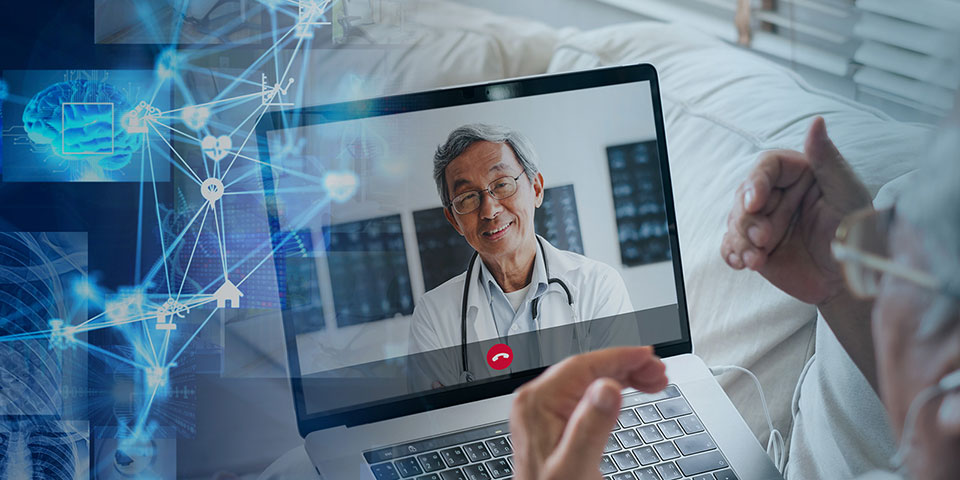As we continue to move through a new year, and even a new era post-pandemic, we look to lists and projections about what the next season, year, or decade will look like. When we consider potential upcoming trends or potential new realities, we often look to the past to see which past predictions actually came to fruition. One of the past seemingly outlandish predictions concerning how we will live our lives in the future shocked us with how quickly it became a reality: telemedicine. Medical professionals have had access to digital health services and care for decades. But for the average person, telemedicine was a new concept until the start of the covid pandemic changed the landscape of healthcare.
The Evolution of Telemedicine
Currently, about 50% of all US healthcare organizations offer some sort of telemedicine option, but medical services provided remotely through technology haven’t always been so widely available or able to help so many people with ease. Telemedicine is simply the practice of caring for patients from a distance but changes in regulations, advances in technology, and a shift in consumer attitude towards healthcare have rapidly increased the accessibility and quality of telemedicine in recent decades.
Regulation Changes Affecting Telemedicine
In the years before the pandemic began in 2020, medical providers were able to offer patient communications through phone calls and occasionally also utilized video platforms to communicate with and treat patients. But security issues, privacy concerns and regulations hindered changes in telemedicine. Specifically, HIPAA laws restricted some patient-provider communications making advances in telemedicine slow and not meaningful for most. Some healthcare organizations offered distance support for patients prior to the pandemic, but the use of telemedicine was not widely embraced or even understood for the average patient. People relied on developing personal relationships with their medical providers for their healthcare, further discouraging people from fully embracing the concept of telemedicine. In addition, before the pandemic, patients did not have direct access to their own health records unless the patient met with their medical practitioner or went to the facility in person in many cases. But once the 2020 covid-19 pandemic hit, the changes in telemedicine changed the future of healthcare forever and created its future trajectory as well.
Technology’s Impact on Telemedicine
With the rapid and overwhelming need to make medicine available virtually to huge numbers of people when the pandemic of 2020 began, the first hurdle to cross was legal. First, the laws and HIPAA regulations governing telemedicine were relaxed to allow a wider range of virtual patient-provider options. The requirement for HIPAA-compliant platforms necessitating encryption, controls and logs was altered to allow virtual visits to take place over popular platforms such as Zoom, Facetime, Google Hangouts and other similarly common video applications. Redefining the way providers could connect with their patients ushered in a new attitude about the future of telemedicine for both patients and providers.
Telemedicine and Consumerization
Now that at-home healthcare is no longer unusual, telemedicine has begun to move towards consumerization. Consumers will continue to drive telemedicine changes, but that shift has already begun. Patients are now able to utilize wearable technologies and connect to their healthcare providers through tracking apps for everything from oxygen to heart rates from home instead of at a provider’s facility. As telemedicine becomes increasingly available and common, providers will also likely increase the use of these types of internet-connected, smart devices to remotely monitor patient progress and health. This access to real-time results has made telehealth more effective for both patients and providers.
Patient Portals
In addition, patients are increasingly in charge of their healthcare choices with the advent of patient portals. Now, providers are giving patients their own remote access to their medical information and health records including scan or test results, input for prescription management as well as the ability to provide input on healthcare decisions for themselves or their loved ones. As consumerism continues to grow, telemedicine will respond accordingly with enhanced access to increasingly sophisticated information provided to patients through patient portals and digital patient-provider contact.
AI Technology and Telemedicine
One of the clear directions that telemedicine will take is an expanded adoption of artificial intelligence-based technology. Most consumers have already encountered AI-powered customer service chatbots on a healthcare provider’s website while some have even experienced an AI-powered therapy screening. This digital application of artificial intelligence is one of the most promising future telemedicine technologies. Not only does it save time and money on patient-facing tasks that can be automated, but it also offers other opportunities where precision is required. AI technology is poised to be a part of such valuable aspects of medicine as genomics, drug research and medical imaging. Research is indirectly beneficial to telemedicine as it provides potential data and information for providers to use to successfully treat and support patients. But AI that manages and interprets medical imaging will directly support and enhance future telemedicine as it gives back some time to providers as well as leans on digitally precise evaluations that may diminish interpretation errors or problems that occur as a result of an overworked or inexperienced staff.
The Future of Patient Evaluation
As virtual evaluations become more commonplace, one of the ways that healthcare will benefit from advances in the use of telemedicine is its increased application of remote patient monitoring and evaluation. Virtual visits that can take place with simply a phone and an internet connection create an opportunity for medical professionals to evaluate patients in critical or emergency situations. In the past, when an accident or medical emergency occurred, patients or their caregivers instigated emergency treatment or access through a 911 call. The quality of the communication, language barriers, or completeness of the description of the emergent situation all played a part in how well the medical professionals arrived prepared to care for the patient. In some cases, the relayed information is incorrect or incomplete, leaving a patient at risk of increased danger or even death in some situations. However, telehealth is now poised to change all of that.
Emergency and Critical Care Telehealth
Virtual evaluations directly with the patient, or of the patient in cases when a caregiver is the one contacting the emergency personnel, could potentially provide crucial information to the medical professionals. Whether a person has developed a life-threatening condition at home or experienced a medical emergency while on vacation or out of the country, a patient can virtually interact with a medical provider through telemedicine technology. A true assessment of the patient can be made by medical providers that can see, hear and potentially interact with a patient before they are personally attended to or picked up by emergency services may be the future of telemedicine. Already in use in some areas, the use of virtual evaluation of critical or emergency care situations is one of the most promising potentials of telemedicine.
Mental Health Applications in Telehealth
The future of mental health treatment and real-time assessments is found in telehealth solutions. Providers will continue to find ways to connect with patients through virtual visits, portals, and personalized strategies to support ongoing mental health concerns. In the past, time lapses between the need for immediate mental health assistance and the availability of a medical professional created sometimes life-threatening situations as well as unhappy or unhealthy patients. As healthcare from a distance continues to improve upon mental health applications like at-home monitoring, apps directed at mental health issues and fast access to medical professionals, the future of mental health treatment will be rooted in telehealth solutions.
Potential Future Concerns
While the future of telemedicine looks promising with many opportunities to increase the quality and availability of provider care, a few hurdles must be overcome as well. One ongoing issue brought to fruition with the pandemic is the difficulties surrounding scheduling appropriate care conveniently and rapidly on a large scale. Providers will need to continue to work with technology platforms that will address this and continue to improve the ability for all patients to connect with their medical professionals easily and when they need to. Another potential concern is that telemedicine may weaken the patient-provider relationship. But as medical professionals are trained in the future to understand how to best connect with their patients, this divide may not ultimately create a problem for patients. As patients who are reticent to embrace telehealth are also shown how virtual medicine and the technologies it brings can benefit them, they will likely be more accepting of telemedicine in the future.
Looking to the Future
As we consider how telemedicine may look in the years ahead, we should remember that a few decades ago, our “normal” was almost inconceivable at that time. While some may have imagined that this century would be full of flying cars and other almost-outlandish norms, we may not have realized that virtual medical care would not only be commonplace but also extremely vital to our health and welfare as well. It is hard to dream up what the future of telehealth may bring, but advances in inpatient evaluation, AI and mental health applications will surely be part of that future.




